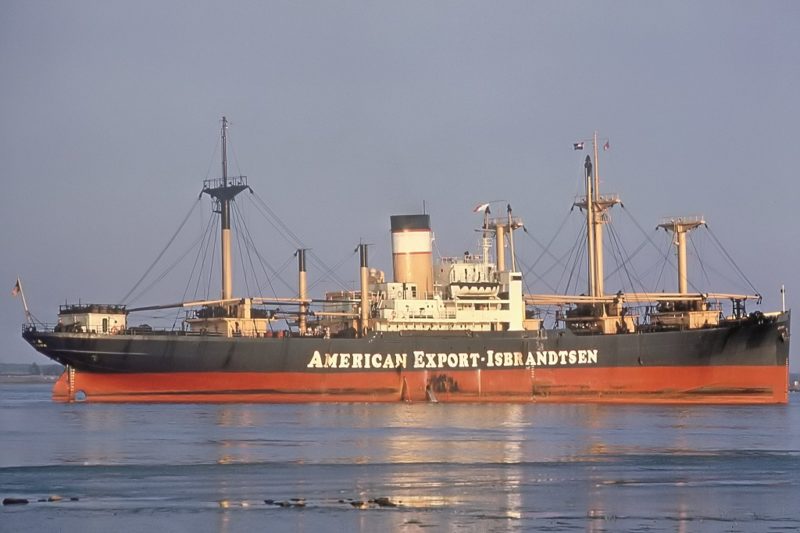
American Export Lines (AEL) was the leading American shipping company offering passenger and cargo services from the Eastern Seaboard of the U.S.A. to Mediterranean ports for 58 years from 1919 to 1977. It was founded in January 1919 by American entrepreneur Henry Herbermann in New York City as the Export Steamship Corporation Inc., using the first of two dozen chartered surplus standard World War I cargo ship types including ‘Hog Islanders’ of up to 9,700 dwt that had been accumulated by the U. S. Shipping Board for war service. They had all been laid up by 1919 and were assigned on charter to the Export Steamship Corporation Inc., with the first Mediterranean sailing from New York on 26th July 1919 by the cargo ship Lake Festina for Gibraltar, Piraeus and other Mediterranean ports, although a few voyages had been made earlier to Antwerp from New York in previous months.
The automobile entrepreneur Henry Ford purchased in 1925 from the U. S. Shipping Board no fewer than 199 smaller laid-up ships including Great Lakes ‘canallers’ for $1.697 million, and similarly Henry Herbermann purchased eighteen much larger cargo ships in 1925 for $1.062 million including sixteen ‘Hog Islanders’ of up to 9,700 dwt. These were not renamed with the familiar ‘Ex’ names of American Export Lines until 3rd August 1928, when 22 cargo ships were owned as the largest privately owned American flag fleet operating to the full range of the Mediterranean ports.
In September 1928, Henry Herbermann was awarded a ten year mail contract to the Mediterranean, and announced that orders had been placed for four passenger and cargo-liners, to be known as the ‘4 Aces’ with a loan of 75% towards the cost of their construction by the U. S. Shipping Board.
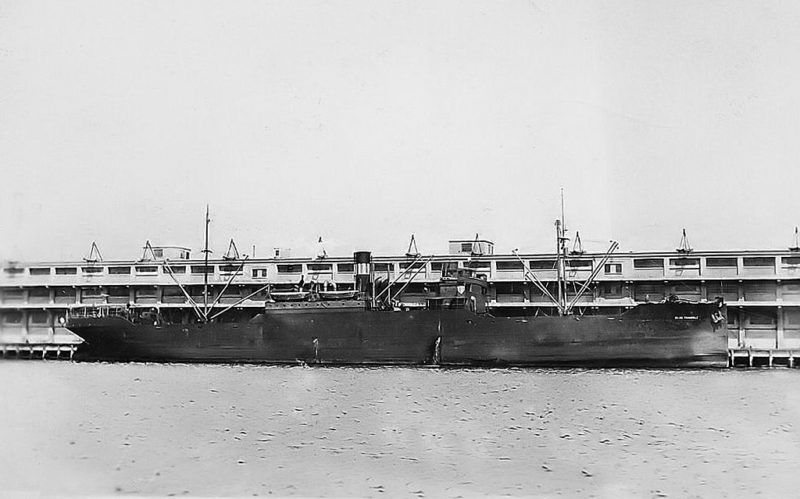
They were named Excalibur, Excampion, Exeter and Exochorda, and carried 150 passengers with a crew of 34, and were built by the New York Shipbuilding Company at Camden (New Jersey) on dimensions of overall length 453.0 feet by moulded beam of 61.7 feet and a moulded depth of 38.6 feet, and with a bridge deck of length 197 feet. They were powered by one single reduction geared steam turbine of 7,200 shp to give a service speed of 18 knots, and their ports of call on schedules issued in May 1932 were from New York to Gibraltar, Marseille, Genoa, Livorno, Naples, Alexandria, Jaffa, Haifa, Beirut and Piraeus. The voyage was of length 43 days and sailed fortnightly from Hoboken in New Jersey, with prices at $460 round trip or for $595 including shore excursions.
The AEL fleet in 1932 was thus as follows:-
Name Built grt Ex Name, Pax
- Examelia 1920 5081 Coeur d’Alene, 12 pax
- Examiner 1919 4969 Sinsinawa, 12 pax
- Exanthia 1920 5673 Half Moon, 12 pax
- Exarch 1921 5839 Naamhok, 37 pax
- Exbrook 1920 4846 Ossa, 12 pax
- Excalibur 1930 9360 ‘4 Aces’, 150 pax
- Excambion 1930 9360 ‘4 Aces’, 150 pax
- Excellency 1919 5052 Liberty Land, 12 pax
- Excello 1919 4990 Luxpalile, 12 pax
- Excelsior 1920 5847 Waterbury, 37 pax
- Exchange 1919 4971 Blair, 12 pax
- Exchester 1920 4965 Winona, 12 pax
- Executive 1920 5109 Carenco, 12 pax
- Exermont 1920 4969 Clontarf, 12 pax
- Exeter 1931 9360 ‘4 Aces’, 150 pax
- Exford 1918 5627 West Carnifax, 12 pax
- Exhibitor 1919 5106 Saucon, 12 pax
- Exilona 1920 5939 Delanson, 37 pax
- Exiria 1919 4969 Corson, 12 pax
- Exminster 1919 4985 Saugus, 12 pax
- Exmoor 1919 4969 Nobles, 12 pax
- Exmouth 1920 5130 Blue Triangle, 12 pax
- Exochorda 1931 9360 ‘4 Aces’, 150 pax
- Explorer 1919 5728 City of Eureka, 12 pax
- Exporter 1919 6629 The Lambs, 12 pax
- Express 1919 4989 Hog Island, 12 pax
- Extavia 1919 5091 C. St. Joseph, 12 pax
- Exton 1919 5083 Sangamon, 12 pax
The ‘Four Aces’ were designed internally by George G. Sharp with their much bigger passenger accommodation, although space had to be found for additional onboard facilities. All Staterooms had private bathrooms, and they sailed with all passengers in First Class on the main Mediterranean route. The Promenade Deck had the Main Lounge, Smoking Room, Staterooms and Country Club Veranda Café, ‘A’ Deck had the Entrance and Reception Hall, a Spacious Veranda aft, and sixteen Staterooms with veranda and shower, and ‘B’ Deck had the double height Dining Room with walk-round gallery and a lounge area above. The timing of their introduction into service at the start of the Great Depression was not helpful to their commercial success.
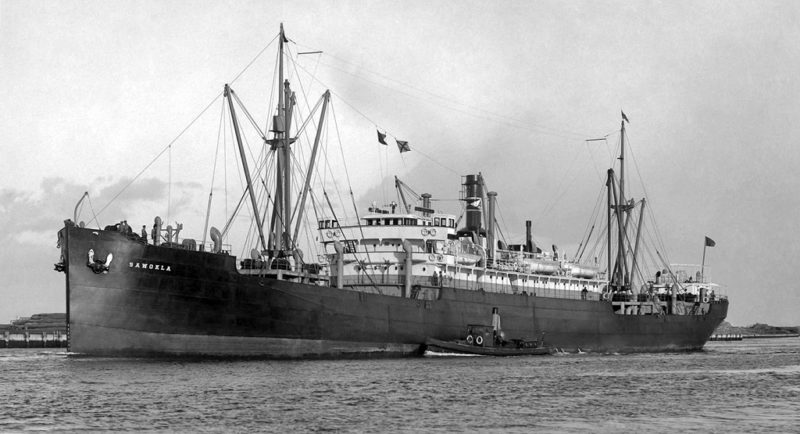
The cargo-liners with much less passenger accommodation ran to different Mediterranean ports than the ‘4 Aces’:-
Black Sea – New York, Gibraltar, Malta, Piraeus, Salonika, Constantinople, Constantza
Italian ports – New York, Genoa, Marseille, Livorno, Naples
North Africa – New York, Casablanca, Tangiers, Ceuta, Melilla, Oran, Tunis
Levant – New York, Malta, Piraeus, Salonika, Constantinople, Constantza, Rodosto, Limassol, Larnaca, Fethiye, Candia, Agia Marina, Volo, Izmir
Africa/Spain – New York, Casablanca, Tangiers, Ceuta, Melilla, Oran, Algiers, Tunis, Barcelona, Alicante, Malaga, Seville, Cadiz, Lisbon
Italy/Spain – New York, Genoa, Livorno, Naples, Lipari, Milazzo, Messina, Palermo, Sfax, Sousse, Algiers, Alicante, Seville, Cadiz, Faro,
Greece/Italy – New York, Piraeus, Salonika, Rodosto, Mytilene, Izmir, Kyllini, Messina, Lipari, Palma, Ceuta, Casablanca
India – New York, Mediterranean ports, Suez Canal-service acquired in December 1939 by purchase of four motor vessels from American Pioneer Line
The founder, Henry Herbermann, resigned as President of the company in March 1934, after the U. S. Department of Commerce demanded a complete reorganisation of the Export Steamship Corporation. The shipping line went through a period of financial uncertainty before acquiring new valuable major shareholders, and with a new company name in 1936 of American Export Lines Inc.
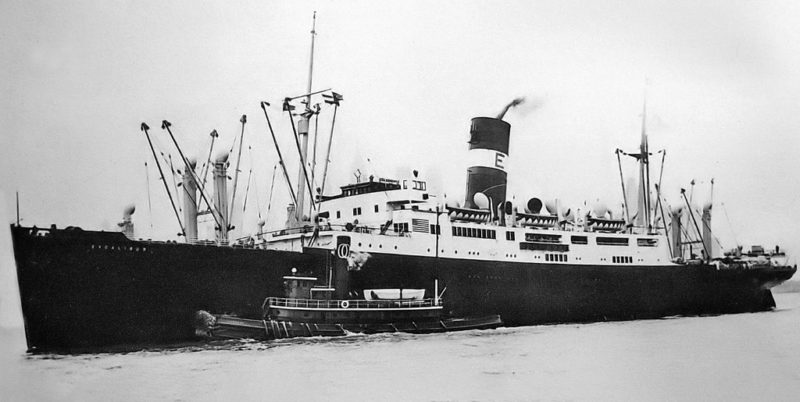
The funnel colours of the fleet between 1919 and 1962 were black with a white central band bearing a blue ‘E’, with two thin red bands between the white and the black, but originally in early days the funnel had a much thinner white band.
Hulls were black with red boot topping and a white dividing line, and ventilators, masts and derricks were buff coloured. In 1939, the company supplemented its steamer passenger and cargo services by introducing flying boats to fly twice weekly between New York and Marseille with a refuelling stop in the Azores.
The ‘Explorer’ Class of eight sister ships was completed during 1938 and 1941 by the Bethlehem Shipbuilding Corporation yard at Sparrows Point to take the place of older vessels in the fleet.
The class had counter sterns, with seven cargo holds served by eight hatches and no fewer than 21 derricks. The latter comprised one heavy lift of 35 tons capacity, four of 6 tons capacity, twelve of 5 tons capacity, four of 3 tons capacity. They measured 6,736 grt, 8,758 dwt and were powered by turbine machinery developing 8,000 shaft horse power to give a service speed of 18 knots. They were transferred to the U. S. Navy and took up military service during the war as their costs had been partly paid for by the United States Government, but their original names were Examiner, Exchange, Executor, Exemplar, Exhibitor, Exporter, Express and Explorer.
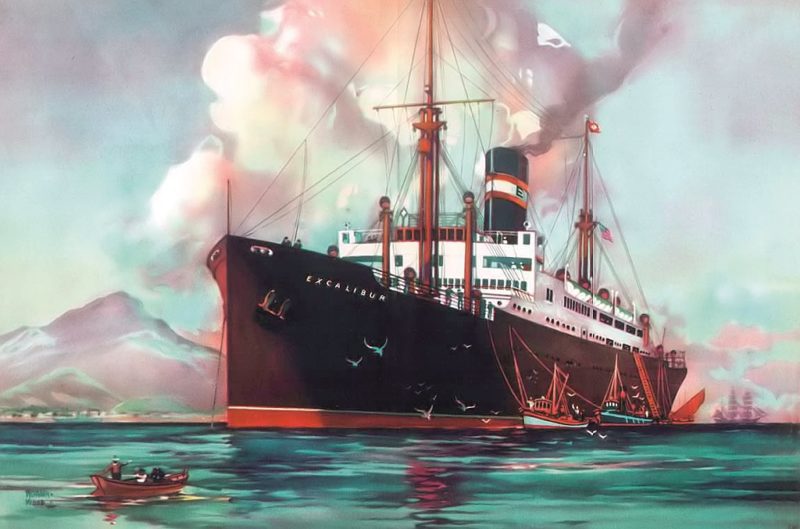
WORLD WAR II
War should never be glorified and only undertaken as the very last resort after all diplomatic efforts have been exhausted to end conflict between nations, or to suppress dictators.
The four year conflict between the U.S.A. and Japan was vicious in nature with no quarter given on either side, and even when Japan was about to lose the war hundreds of ‘kamikaze’ suicide planes were targeted at the American and British warships to cause further loss of life.
The large passenger accommodation of the pre-war ‘4 Aces’ made them ideal Attack Troop Transports (APA) for the seaborne invasions of many Pacific islands that had to be regained from the Japanese military during the advance to Japan.
These fast, steam turbine powered ships saw much war service, with Exochorda winning seven ‘Battle Stars’ for her exploits during seven invasions. The American Export Lines big fleet of turbine powered cargo ships, both those already in service and new war-built ships, made ideal Troop Transports (AP) and Troop Attack Transports (APA) throughout the war.
A former AEL cargo ship, Exmoor, that had been sold in 1941 before the Pearl Harbour attack by the Japanese on the Hawaiian Islands on 7th December 1941, nearly provoked an early response by the U.S.A. military for her loss by torpedo on 21st May 1941.
She was a ‘Hog Islander’ built in 1919 as Nobles, and was sold to the Seas Shipping Co. In. of New York and renamed Robin Moor. She sailed from New York with a general cargo of 450 cars and trucks, steel rails, machine tools, agricultural chemicals, lubricants in drums, as well as sporting rifles and ammunition for South Africa and Madagascar.
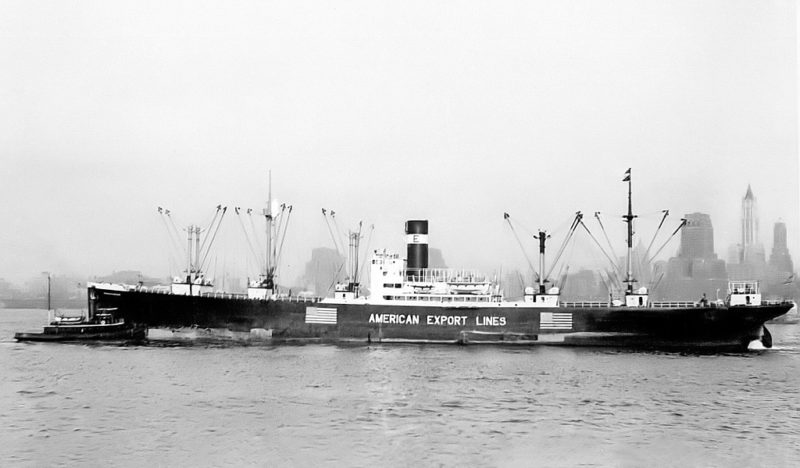
She was commanded by her Master, nine officers and carried a crew of 39 together with eight passengers. U69 stopped the ship at 0525 hours on 21st May 1941 in mid-Atlantic near the Equator, and after allowing all personnel to launch and take to the lifeboats, torpedoed and shelled the neutral ship.
All aboard had a rough time in open lifeboats before being picked up by the Ellerman ship City of Wellington on 2nd June and were landed at Cape Town 16 days later.
President Franklin D. Roosevelt stated that the sinking of the neutral Robin Moor must be taken as a warning to the U.S.A., and all German assets in the U.S.A. were frozen with consulates and embassies closed. Demands for recompense from Germany fell on deaf ears.
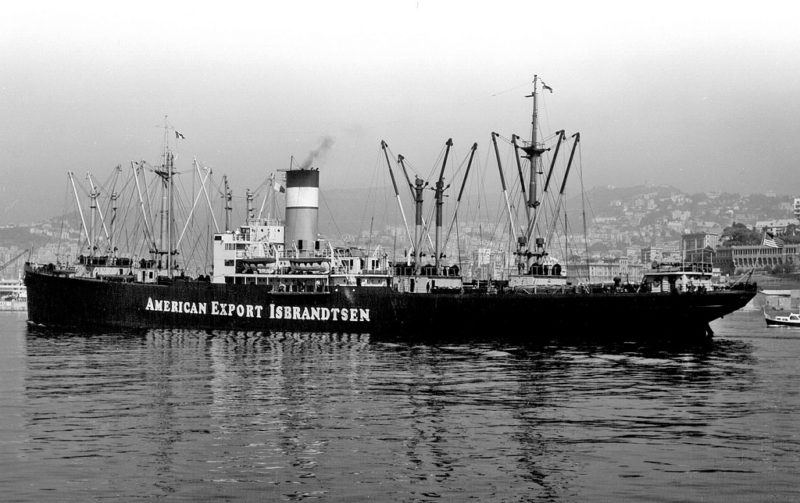
The war service of the pre-war ‘4 Aces’ was as follows:-
Excalibur
She began the shorter neutral Transatlantic passenger service from New York to Lisbon on 18th July 1940, and on one of these later voyages from Lisbon she carried the Duke and Duchess of Windsor on their evacuation to the Bahamas via Bermuda. Excalibur carried neutral markings on her black hull of two huge ‘Betsy Ross’ American flags and ‘American Export Lines’ in large white block letters. She was converted in late 1941 to the U.S. Navy troop transport Joseph Hewes (AP 50) and fitted with a pole radar mast atop her navigating bridge and two 3” guns up forward as anti-aircraft protection. She sailed on 24th October 1942 from Hampton Roads in the Western Naval Task Force for the American landings in Morocco as part of Operation Torch. The 1,074 troops and 80 officers of the 3rd Infantry Division disembarked at Casablanca on 8th November 1942. She sailed three days later from Casablanca but later that day she was torpedoed by U-173 and sank with the loss of her Master and one hundred crew. She received one ‘Battle Star’ for her service.
Excambion
After continuing initially on her Mediterranean and then Lisbon to New York sailings, she was converted to the U.S. Navy troop attack transport John Penn (APA 23) in 1941. She took part in the American troop landings at Casablanca in November 1942 as part of Operation Torch, and then sailed via the Panama Canal to New Caledonia, arriving on 18th January 1943 and at Espiritu Santo three days later. She picked up the survivors from the sunken cruiser Chicago off Guadalcanal on 29th January 1943, and was then employed for the next six months on delivering troops, supplies and equipment for the Guadalcanal campaign from the New Hebrides, Fiji and New Zealand. On 13th August 1943, she was torpedoed by a Japanese torpedo bomber off Guadalcanal with another torpedo bomber crashing in flames on her mainmast after she had unloaded her ammunition at Lunga Point. She sank later that day, and received one ‘Battle Star’ for her enormous contribution to the successful recapture of the Solomon Islands.
Exochorda
She was the most decorated of the pre-war ‘4 Aces’ class, winning seven ‘Battle Stars’ during seven invasions in the Pacific War, and had also seen service in the Caribbean and on the North Atlantic. She continued with her commercial Mediterranean sailings in 1940 until she was converted later that year into the U.S. Navy attack transport Harry Lee (APA 10) at the Brooklyn Navy Yard in New York. After surviving six years of war service, she arrived back at the Brooklyn Navy Yard on 9th February 1946 and was placed into the mothballed reserve fleet until 1948. In April 1948, she was sold to Turkish State Maritime Lines and renamed Tarsus and given an extensive refit with her aft twin kingposts removed, her Promenade Deck completely rearranged with new floor to ceiling windows in the forward section while the aft section remained open to the weather. She had new funnel colours of yellow with a black top and a white central band carrying the yellow logo of her owners, with a black hull initially and a white line but later changed to a white hull. She then had accommodation for 189 passengers in First Class, 66 in Second Class, and 210 in basic Third Class dormitories. She became a very popular Turkish Mediterranean liner, but as with her three sisters she was lost in service, by fire in December 1960 after a blazing oil tanker drifted into her in the Bosphorus at Istanbul and she was completely gutted.
Exeter
Exeter was the last of the ‘4 Aces’ to enter service in late 1931, and she followed the pattern in service of her sister Excalibur. She was accepted into the U. S. Navy as troop transport Edward Rutledge (AP52) on 17th January 1942 and commissioned on 18th April 1942. She sailed from Tampa on 13th May 1942 in convoy for Hampton Roads, and after loading her troops, sailed on 24th October 1942 from Hampton Roads in the Western Naval Task Force for the American landings in Fedala Bay, French Morocco as part of Operation Torch. The invasion troops of the 3rd Infantry Division disembarked there on 8th November 1942. However, later in the day of 12th November 1942 she was torpedoed by U-130, which had slipped through the escort screen to sink three transports off Fedala Bay. She sank by the stern with the loss of 15 members of her crew, and she later received one ‘Battle Star’ in recognition of her service.
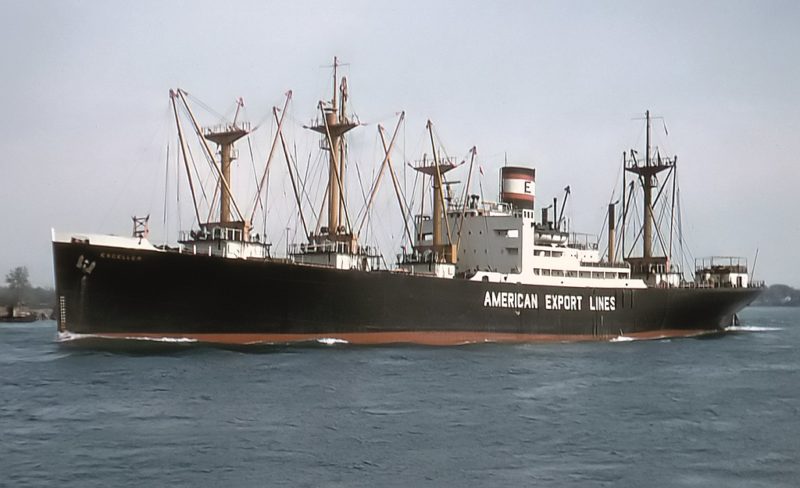
‘Windsor’ class of Attack Troop Transports (APA)
A number of conversions were completed during 1944 as the ‘Windsor’ class of Attack Transports (APA) able to carry 1,460 troops and 94 officers including the invasion headquarter staff.
These were USS Queens (APA-103), USS Dutchess (APA-98), USS Shelby (APA-105), USS Dauphin (APA-97), USS Leedstown (APA-56) and USS Windsor (APA-55). After the end of their war service, the first four named were converted in 1948 to the AEL ‘4 Aces’ passenger and cargo ship replacements and renamed Excambion, Excalibur, Exeter and Exochorda.
USS Leedstown (APA-56) was the most decorated of the ‘Windsor’ class, richly earning her six ‘Battle Stars’ as head of the Battle Invasion Fleet at six Pacific island invasions at Guam, Guadalcanal, Pelelius, Leyte, Luzon, and Iwo Jima.
USS Dutchess (APA-98) was named after a County in New York State and not a ‘duchess’, and earned one ‘Battle Star’ for her troop landings at Okinawa, which was a bitter stalled campaign lasting months with many thousands of American infantry losses. USS Dauphin (APA-97) earned one ‘Battle Star’ during the seaborne assault on Okinawa, and she was present in Tokyo Bay for the surrender ceremony of Japan on 2nd September 1945.
USS Queens (APA-103) was used on trooping in the Pacific from arrival on 2nd March 1945 at Pearl Harbour and did not take part in any seaborne invasions, but trooped to Guam, Eniwetok, Saipan and Sasebo in Japan. She made one ‘Operation Magic Carpet’ sailing from the Philippines in September 1945, and was decommissioned at Norfolk (Va) in June 1946.
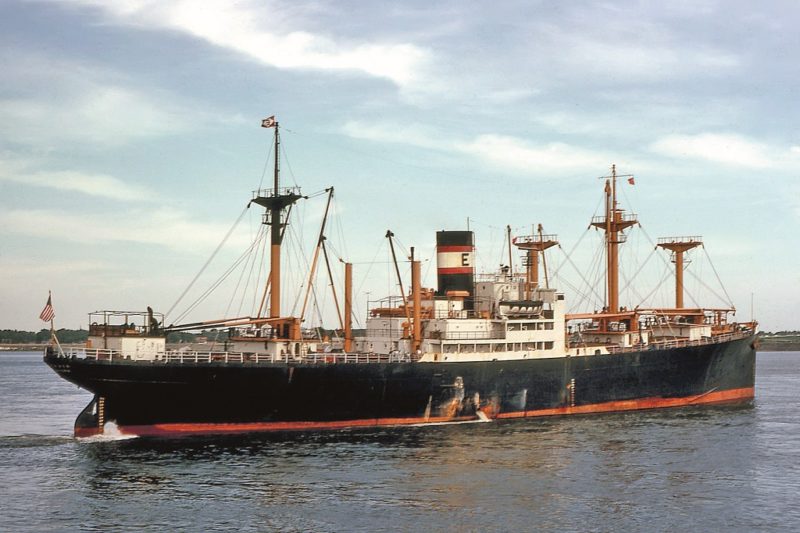
The namesake of the ‘Windsor’ attack transports class was commissioned on 17th June 1943 as USS Windsor (APA-55) and sailed from Pearl Harbour on 22nd January 1944 bound for the Marshall Islands as part of Task Force 52.
She earned her five ‘Battle Stars’ at the invasions of Kwajalein, Saipan, Guam, Peleliu and Leyte, and after the end of the war she was part of the occupation force in Japanese ports.
During the six weeks from 19th November 1945 until the end of the year, she transported returning American troops to the U.S.A. as part of the happy ‘Operation Magic Carpet’. She decommissioned on 12th April 1946 and was delivered into lay-up on 1st August 1946 until reactivated for AEL service in 1948 as Expeditor.
Exemplar was launched on 22nd June 1940 by the Quincy yard of the Bethlehem Shipbuilding Corporation, and was completed three months later as a member of the ‘Explorer’ class.
She was commissioned into the U.S. Navy on 17th September 1942 as the Troop Transport Dorothea L. Dix (AP 67) and went on to earn five ‘Battle Stars’ during the war. She sailed with Task Force 34 for Operation Torch landings and assault at Safi in French Morocco on 8th November 1942, landing both troops and supply scout boats. She had made two more Transatlantic sailings with troops, nurses and supplies to Oran by 5th April 1943.
She was present at the invasion of Sicily at Scoglitti on 9th July 1943 and disembarked her troops and supplies under heavy air attack during the following day.
She returned to New York and made another voyage to Oran, arriving on 21st September 1943 and sailing on 8th October for Gourock. She sailed from Gourock on 27th October 1943 for Algiers to pick up the crew of the sunken American destroyer Beatty (DD 640), and also picked up more returning troops from Oran.

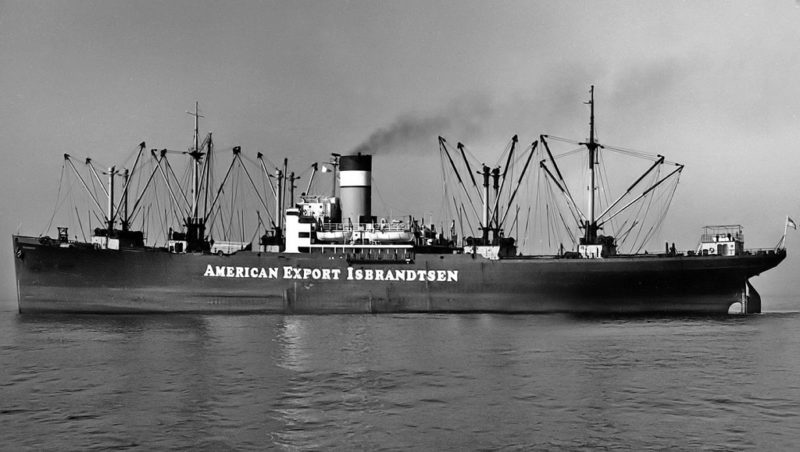
Exemplar as Dorothea L. Dix (AP 67) trooped from New York to Gourock and Liverpool, and then to Belfast arriving on 3rd April 1944 for amphibious training prior to the D-Day landings in Normandy. She sailed with Transport Division Command 97 on 5th June 1944 from Portland for Normandy, returning to Weymouth Bay to disembark casualties.
She sailed for Naples from the Clyde and Avonmouth with troops and tanks, which were destined for the invasion of Southern France on 15th August 1944. She continued to support these landings with Allied troops from four nations to Marseille and the Baie de la Cavalaire from Oran and Naples until 22nd October 1944. She then transferred to the Pacific War and arrived at Pearl Harbour, Hawaii from San Francisco in January 1945. She transported troops to the island base at Attu in the Aleutian Islands, and then moved down to Okinawa, arriving on 1st May 1945.
The large number of injured troops at Okinawa were embarked and arrived at San Francisco on 27th May 1945 for further recovery from their injuries.
She continued repatriating troops from the Philippines until her last troop arrival at San Francisco on 9th February 1946.
She was decommissioned at New York on 24th April 1946, and after a lengthy refit resumed service for AEL as Exemplar in late 1946.
The American Export Lines cargo ship losses to U-boats and other causes:-
Exmoor – Shelled and sunk by Japanese warships on 6th April 1942 while on a voyage from Calcutta to Colombo with manganese ore, jute and gunnies, all of her crew were saved.
Express – Torpedoed and sunk off Madagascar by the Japanese submarine I-10 on 28th June 1942 while on a voyage from Bombay to Cape Town with manganese ore and general cargo, 14 of her 56 crew were lost.
Examelia – Torpedoed and sunk by U-68 off Cape Agulhas with the loss of 11 lives on 9th October 1942 while on a voyage from Calcutta and Colombo to Cape Town and New York with manganese ore and general cargo. However, 26 of her survivors were lost when being repatriated on the Dutch ship Zaandam.
Excello – Torpedoed and sunk by U-181 as Sinsinawa of subsidiary American Pioneer Line on 13th November 1942 with the loss of two lives.
Excellency – Shelled and sunk on 29th November 1942 as Sawokla of subsidiary American Pioneer Line while on a voyage from Calcutta and Colombo to New York by surface raider Michel (N 18), crew saved, one taken prisoner.
Expositor – Torpedoed and sunk by U-303 off Newfoundland on 22nd February 1943 while on a voyage from Liverpool to New York in ballast, six lives were lost from her crew of 60.
Executive – Torpedoed and sunk by U-255 on 5th March 1943 in Murmansk convoy RA 53 with the loss of 9 lives, having sailed from Loch Ewe with a crew of 38 and 24 armed guards.
Exmouth – Mined and sunk on 31st July 1944 off Arbroath while on a voyage from Hull to New York in a British minefield, all 68 crew were saved.
Exford – Sunk as a blockship at Mulberry Harbour, Normandy on 26th August 1944.
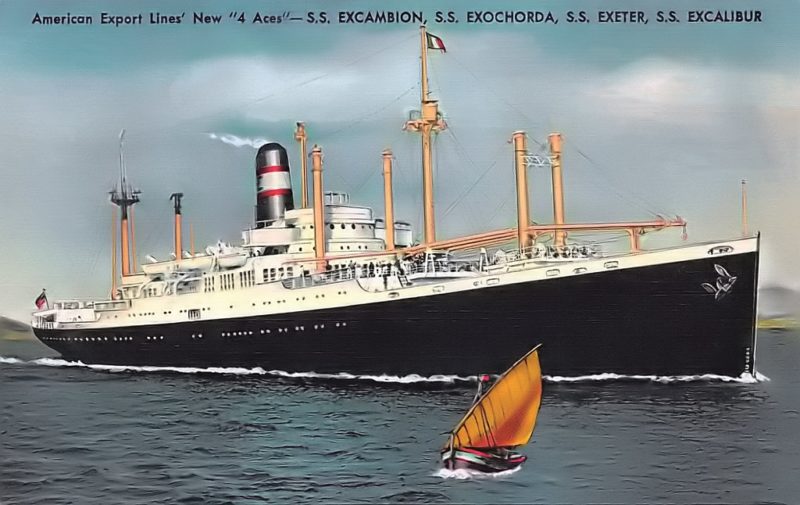
POST-WAR EXPANSION
Twenty-two war built ships from the Bethlehem Shipbuilding Corporation, and four that had been built by the Bath Iron Works during the war passed back to commercial trading with American Export Lines between 1946 and 1948, and were followed in 1948 by two ‘Victory’ standard types built on the West Coast of the U.S.A. These were:-
Name Built Class
- Excambion 1944 4 Aces pax/cargo conversion
- Excalibur 1944 4 Aces pax/cargo conversion
- Exeter 1944 4 Aces pax/cargo conversion
- Exochorda 944 4 Aces pax/cargo conversion
- Excelsior 1943 Explorer class
- Exemplar 1942 Explorer class
- Examiner 1942 Explorer class
- Exchange 1940 Explorer class
- Exhibitor 1940 Explorer class
- Explorer 1939 Explorer class
- Exchequer 1943 Explorer class
- Express 1944 Explorer class
- Executor 1945 Explorer class
- Expeditor 1944 Explorer class
- Excellency 1940 Explorer class
- Exporter 1945 Explorer class
- Exermont 1939 Explorer class
- Exilona 1943 Explorer class
- Exbrook 1946 C3-S-A3 class
- Exchester 1945 C3-S-A3 class
- Exeter 1945 C3-S-A3 class
- Exford 1946 C3-S-A3 class
- Exminster 1944 C3-S-A3 class
- Exanthia 1942 Built by Bath Iron Works C2-S-A1 class
- Exceller 1941 Built by Bath Iron Works C2-S-A1 class
- Exiria 1942 Built by Bath Iron Works C2-S-A1 class
- Extavia 1941 Built by Bath Iron Works C2-S-A1 class
- Exmouth 1945 Victory type
- Exton 1945 Victory type
The conversion of the ‘4 Aces’ in 1948 into a very traditional outward design together with very modern interior design required the complete stripping down of the quartet into bare hulls.
An entirely new and modern superstructure was built that included the passenger staterooms on the Promenade Deck and ‘A’ deck, as had been on the pre-war ‘4 Aces’. The well-known industrial designer Henry Dreyfuss, who had previously worked for the New York Central Railroad and Bell Telephones, designed the interiors and the air-conditioned and sound proofed staterooms, as well as the glass enclosed Promenade Deck with a swimming pool, modern bar, smoking room and children’s playroom. They were fitted with the latest fire extinguishers, smoke detection, fire control, and fireproofing systems. Artists were commissioned for the opulent murals and artwork that heavily reflected the ports of their Mediterranean route.
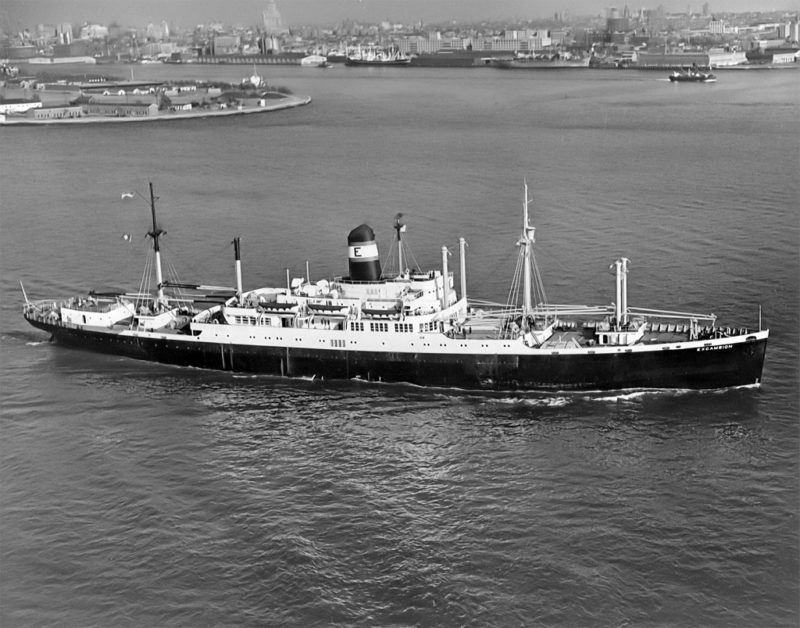
However, by 1959, American Export Lines were feeling the competition on the Mediterranean from Zim Israel Lines, Italia Line and Greek Line, with Exochorda and Excambion both laid up that year, leaving Excalibur and Exeter to carry on sailing the route. The U.S. Maritime Administration awarded Exochorda to the Stevens Institute of Technology in October 1967 and she was renamed Stevens for $130,300 and she was towed from the Hudson River Reserve Fleet to the Bethlehem Steel Corporation yard at Hoboken to be refurbished as a dormitory. When she had finally reached the end of her usefulness, she was scrapped between 1975 and 1979 at Chester (PA) and Kearny (NJ). Excambion was sold in 1965 to the State of Texas and renamed Texas Clipper as a training ship for the Texas Maritime Academy until she was laid up in 1994. She became Texas Clipper II in 1997 and then became a candidate for the Texas Artificial Reef Programme. She was towed from Beaumont (TX) to a wrecking yard at Brownsville (TX) to be readied environmentally for sinking, which occurred on 17th November 2007, 17 miles off the coast of Port Isabel. Many former students watched her sink in 130 feet of water, and she is accessible by experienced divers.
Excalibur returned to the New Jersey terminal of AEL at the end of her last voyage on 16th December 1964 and was laid up for some time until sold to C.Y. Tung of Hong Kong along with Exeter to become Oriental Jade and Oriental Pearl respectively. A new Transpacific service from Hong Kong, Kaohsiung, Keelung and Kobe and Yokohama to San Francisco, San Diego and Los Angeles was their final role. They had light grey hulls and the familiar ‘Plum Blossom’ funnel colours of Tung, and served him for almost ten years before both were broken up at Kaohsiung.
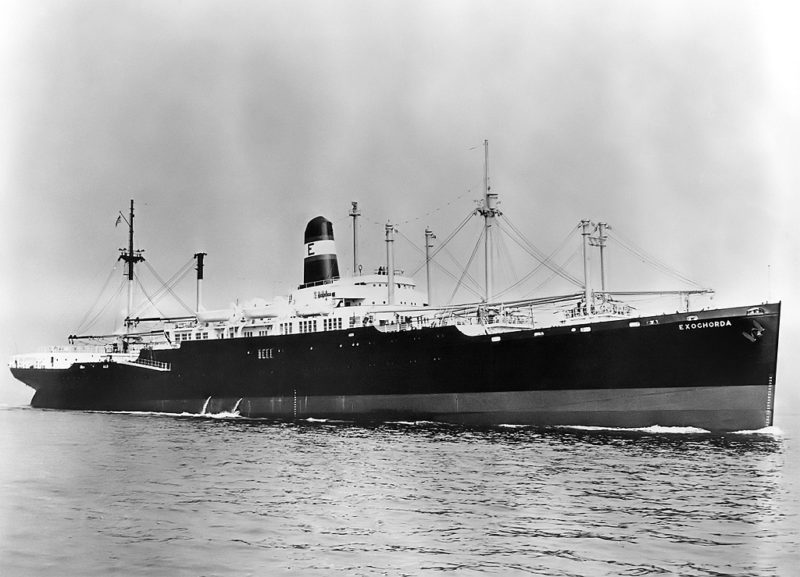
INDEPENDENCE and CONSTITUTION
The Mediterranean passenger trade was of such great importance to American Export Line that their only surviving passenger liner in 1946, Exochorda of 1931, which had undergone such arduous war service as the Attack Troop Transport Harry Lee (APA-10), was not rebuilt but was sold off to Turkish Maritime Lines rather than pay the prohibitive cost of extensive rebuilding.
As a stop gap in 1946 to restart the passenger service, the Italian liner Vulcania, built in 1927, was chartered for six round voyages with the last ending at New York on 1st November 1946. Five chartered engines aft ‘C4’ types with passenger accommodation had also been brought in to help out from April 1946 in Marine Flasher, Marine Jumper, Marine Perch, Marine Shark and Marine Carp until they were no longer needed by the Spring of 1949. They each carried between 850 and 930 passengers in austere dormitory accommodation, and the fare per person reflected this at only $225 to Italian ports.
The order for two sleek twin funnelled passenger liners with accommodation for one thousand passengers in the up-market clientele sector was announced in November 1947, their gross tonnage under American measurement rules being 23,720, but under European measurement rules a higher figure of almost 30,000 grt.
The orders were given to the Quincy (Mass.) yard of the Bethlehem Shipbuilding Corporation, with half of the cost borne by the United States Government so that they could be used as troopships in wartime. Independence was launched first on 3rd June 1950 and her identical sister Constitution followed her into the water on 16th September 1950.
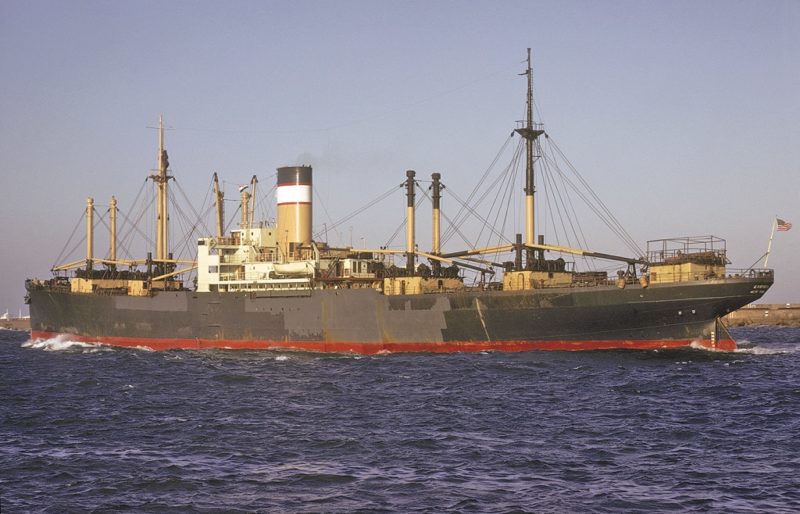
The design of this sleek pair of cruise-like passenger liners featured a ‘cutaway’ counter stern, twin domed funnels, a tall mast above the navigating bridge, and four derricks to work cargo into the forward and aft holds. Liners of their size in earlier decades had over one thousand passengers, but sophisticated up-market passengers demanded more onboard facilities that took up space. Their hulls had overall lengths of 682.5 feet, moulded beam of 89.2 feet, and a loaded draft of 30.2 feet, with a deadweight tonnage of 7,250 tonnes. They were powered by twin Bethlehem steam turbines of 55,000 shp to give very good service speeds of 23 knots. They would compete with modern liners of Greek Line, Italia Line and Zim Israel Lines, and thus their service route would only be from New York to Algeciras in six days, Cannes and Genoa in eight days, and Naples in nine days. This allowed the new ‘4 Aces’ quartet that entered service after complete rebuilding in 1948 to serve the full range of West and East Mediterranean ports.
Independence sailed on her maiden voyage on Saturday, 10th February 1951 from New York to Madeira, Casablanca, Cadiz, Gibraltar, Tangiers, Malaga, Algiers, Palermo, Naples, Piraeus, Haifa, Larnaca, Beirut, Alexandria, Istanbul, Naples, Genoa, Cannes, Barcelona, La Palma (Mallorca), Gibraltar, and Lisbon, and arrived back at New York on Wednesday 4th April 1951 after 53 days of promotion and showing off her sleek lines.
Constitution made her similar maiden voyage from New York on 25th June 1951 and was fully booked with 205 First Class passengers, 407 Second Class passengers, and 395 Third Class passengers. The interiors had been designed by the interior designer Henry Dreyfuss and featured First Class Penthouse Suites, separate Dining Rooms for First Class and Second Class passengers, handsome lounges, bars and public rooms decorated with modern art, ship models in bottles, and coloured murals showing Mediterranean ports of call. The Observation Lounge of length 125 feet featured full length picture windows fitted with polarised glass to control glare and light, and staterooms had bedside telephones able to make calls back to the United States across the full length of the North Atlantic. First Class passengers also had reading and writing rooms, and one for playing card games, as well as a poolside café. First Class one-way fares from New York to Cannes were $422, Cabin Class $317, and Tourist Class $253.
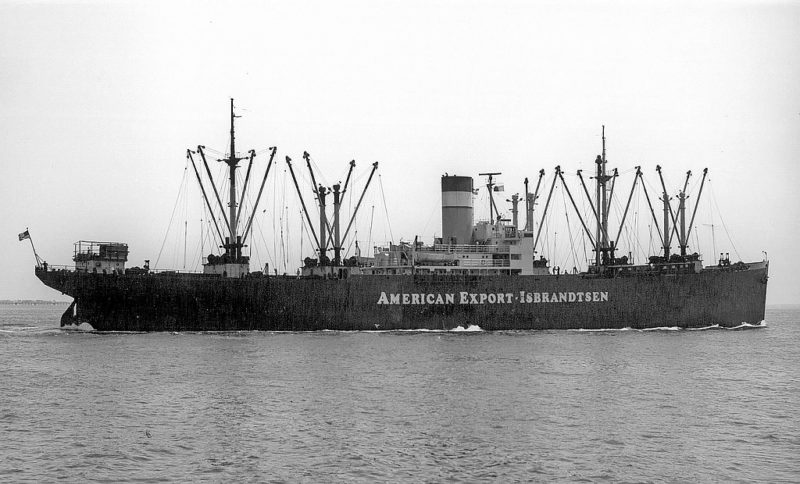
The express service to Gibraltar, Cannes, Genoa and Naples ran fully booked in summer months, as it was marketed as ‘Sunlane’ cruise-like sailings to the sunny Mediterranean, but was extended in length in Autumn and Winter to include a collection of more interesting ports such as Madeira, La Palma, Portofino, Alghero (Sardinia), Ponta Delgada (Azores) and Casablanca, as well as Heraklion, Rhodes, Mykonos, Delos, Santa Cruz de Tenerife and Las Palmas de Gran Canaria to offer more of a cruise to keep passenger numbers up during the non-peak off season. The pair were refitted in 1959 with a whole deck of cabins added to give an extra 110 berths behind the navigating bridge to offer winter cruises from New York to the Caribbean as one-class cruise ships with good accommodation at competitive fares to compete with Furness Bermuda Line, resuming their Mediterranean passenger trade in Spring each year. Constitution collided with the Norwegian tanker Jalanta on 1st March 1959, but after thirteen days of repairs she was ready for her Mediterranean service.
Celebrities sailed on these two great liners, including Grace Kelly and Prince Rainier III of Monaco travelling to their wedding in Monte Carlo in April 1956, Hollywood stars Greta Garbo, Deborah Kerr, John Wayne, Glenn Ford, Mary Pickford, Peter Ustinov, Cecil B. de Mille, Lucille Ball, Desi Arnaz, Cary Grant and Gina Lollobrigida, as well as Walt Disney and Alfred Hitchcock, President Harry Truman and his wife, Ronald Reagan and his wife Nancy, the Pope and cardinals and bishops and King Saud of Saudi Arabia. At least two full length feature films and one TV series were made aboard Constitution. The general seagoing public got the message that this pair of sleek liners were preferred by fashionable and influential people.
American Export Lines had chartered the former troopship La Guardia (ex General W.P. Richardson) during 1949 to 1951 for a separate service to Haifa from New York to solve a political problem, as their quartet of ‘4 Aces’ had hit problems with cargo that arrived at Haifa including guns and ammunition destined for Beirut, resulting in the quartet being banned to continue on to Beirut with armaments, and thus it became impossible to trade with both Israeli and Arab ports. La Guardia was named in honour of the Mayor of New York, and her refit cost $5 million to give accommodation for 157 passengers in First Class and 452 in Tourist Class. The first voyage was from New York on 27th May 1949 with First Class fares per person ranging from $385 to $830 for the ten day voyage.
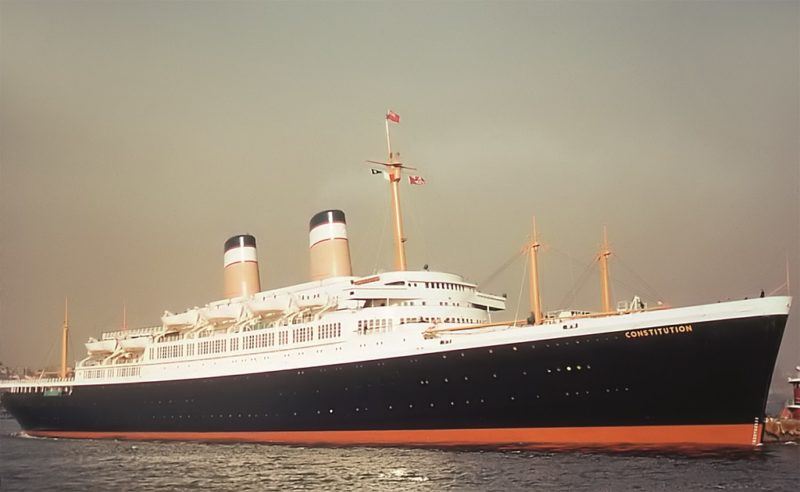
A third liner, the white hulled Atlantic of 14,138 grt, and formerly Badger Mariner of a converted ‘Mariner’ class cargo ship built in 1953, began on this service to Haifa in 1960 via Spanish, Italian and Greek ports, but her service was gradually extended to offer the full range of Mediterranean ports. She carried 860 Tourist Class passengers but only 40 in First Class. The latter had the choice of five starters for their evening dinner, with six main course choices and six dessert choices followed by coffee, cheese and biscuits and after dinner mints. The crew also ate well, with ten choices for breakfast, six choices for lunch, and six choices for dinner.
The year of 1966 was the last full year of operations for Constitution, Independence and Atlantic. Constitution and Independence operated seven day, ten day and fourteen day cruises from New York for six months of the year from October to April. A wide range of Caribbean ports were visited including San Juan, St. Thomas, Guadeloupe, Martinique, Barbados, Trinidad, Curacao, St. Maarten and St. Croix. Independence also undertook a much longer 60 day cruise from 26th February 1966 to 26th April 1966 and after sailing from New York called at Fort Lauderdale, Mindelo Island (Cape Verde Islands), Dakar, Tenerife, Madeira, Casablanca, Gibraltar, Alicante, La Palma, Cagliari, Valletta, Alexandria, Beirut, Haifa, Izmir, Istanbul, Lesbos, Mykonos, Delos, Piraeus, Hydra, Corfu, Kotor Bay, Dubrovnik, Venice, Bari, Messina, Naples, Elba, Portofino, Genoa, Monte Carlo, Cannes, Barcelona, Ceuta, Tangiers, Lisbon, Ponta Delgada, Fort Lauderdale and return to New York. The liner Atlantic offered a Caribbean cruise season of six months duration on seven day, ten day and fourteen day cruises, with four nights and days in Bermuda on a seven day cruise from New York.
Atlantic was withdrawn from service in 1967, but Constitution and Independence continued in service, offering 21 day cruises for First Class fares in the range up to $3,903 and up to $875 for Cabin Class per person based on two person occupancy per cabin. Tourist Class passengers were not carried on these ‘Sunlane Cruises’.
In 1968, both Constitution and Independence were chartered as ‘Funships’ on full time cruise duty, chartered to the American Travel Agency and Diners Club/Fungazy as one class cruise ships to appeal to a younger market. Independence was repainted in dry-dock at Baltimore (MD) over a period of three months with the most enormous and magnificent ‘Sunburst’ in yellow and brown over all of her hull, superstructure and both funnels. The hemispherical yellow sun at the waterline featured the eyes of film star Jean Harlow, and the interiors of the ship featured coloured paintings of tigers, ‘pop art’ and other graphics on staircases and on the bottom of the swimming pools.
The template for the ‘Sunburst’ had been drawn by hand on a single piece of paper and given to a Baltimore painting contractor to work it out over lifeboats, superstructure and both tall funnels. The ‘Sunburst’ was very eye catching, but did not attract enough new young cruisers on the novel method of paying only up front for the passage, with meals, extras and shore excursions paid onboard. She was laid up at Jacksonville after the end of the last ‘Funship’ cruise on 9th September 1968.
However, even the very best of glossy marketing could not compete with the speedier flights to the Mediterranean from New York, and the service faltered with Atlantic laid up in 1967, Constitution laid up in 1968, and Independence also laid up in 1968. The famous AEL Mediterranean passenger service had ended with all three liners laid up. Independence and Constitution later had long careers as cruise liners for 950 passengers after being sold in 1974 to C.Y. Tung of Hong Kong for his Atlantic Far East Lines until laid up again in 1976 as Oceanic Independence and Oceanic Constitution. In 1980, C.Y. Tung obtained permission from the U.S. Government to operate the pair in American waters for his American Hawaiian Cruises as they were no longer American flagged liners. Oceanic Independence was refitted at the Kawasaki Dockyard in Kobe to carry 950 passengers on seven day cruises around the Hawaiian islands from June 1980, and regained her original name in 1982. Oceanic Constitution followed after a refit in Taiwan and began cruising from Honolulu in June 1982 as Constitution after being re-christened by Princess Grace of Monaco.
Passenger capacity on both Independence and Constitution was reduced to 800 in 1984, and in 1987 both ships were officially registered in Honolulu. Independence was given a full refit by the Newport News Shipbuilding & Dry Dock Company, but two years later Constitution came to the end of her active seagoing career and was used for cannibalisation of spare parts for her sister. Independence celebrated her one thousandth voyage in August 1999 as the very last U.S. ocean liner to sail under the American flag. However, American Hawaii Cruises was bankrupted in 2001, and Independence became the property of the U.S. Maritime Administration and arrived for lay-up at Pier 70 in San Francisco on 8th November 2001.
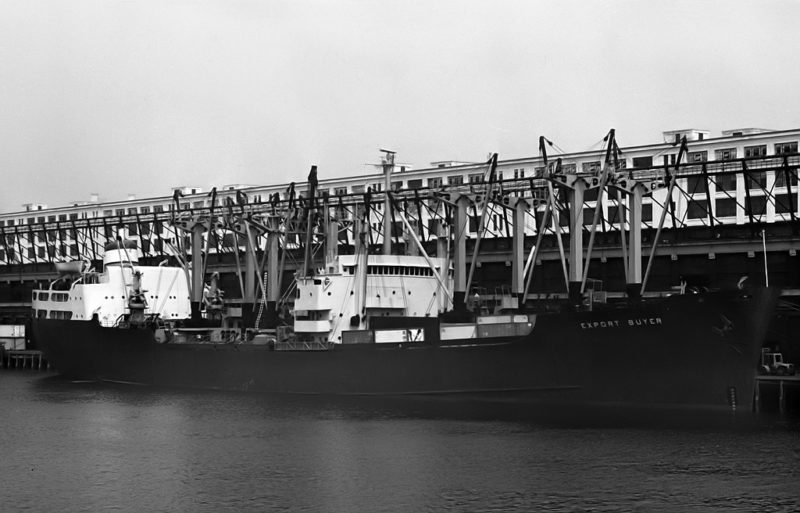
Despite Independence being sold to Norwegian Cruise Line for $4 million in February 2003, she remained in lay-up, and was renamed Oceanic in summer of 2006 after a seven day Hawaiian cruise operation planned by NCL had failed to materialise. Oceanic was towed out of San Francisco beneath the Golden Gate Bridge on 8th February 2008 for Dubai, in readiness for a final tow to the scrapyards of Alang in India. However, her tug lost all power on this last tow and another tug had to be sent to assist the first tug. She was beached at Gopnath in a region to the south of Alang as claims were made that she had toxic radioactive material and asbestos onboard. She was a product of ship construction in 1950 and was no more toxic than any other later ship, but the hull of Independence had become cracked with only mud holding it together, and she was broken up ‘as lies’ during 2010 with the last visible piece gone by January 2011.
Constitution had sunk on 17th November 1997 some 700 nautical miles to the north of the Hawaiian Islands while being towed for breaking up to the Far East. The third AEL liner Atlantic had a very successful later career as the cruise liner Universe until she was broken up in 1996. The long and successful American Export Lines Mediterranean passenger services had lasted almost forty years from 1930 in that glorious long period of sea passenger travel.
AMERICAN EXPORT-ISBRANDTSEN LINES
Hans Isbrandtsen was born on 7th September 1891 near Copenhagen to parents Jacob C. Isbrandtsen and Nicoline J. Isbrandtsen. He served at sea for some time before moving to the U.S.A. to manage the New York office of the American Trans-Atlantic Company established by Danish shipowners to secure unhindered movement of Danish ships in the British and German blockades of European waters in World War I. He had formed a shipping company in 1917 under his own name in Delaware, together with the Pan American Terminal & Dock Corporation in New York as he had interests in stevedoring. Hans Isbrandtsen was a very clever man and few in the shipping industry argued with him. The great shipping magnate Arnold Peter Moller (1876-1965) of Copenhagen in Denmark was his cousin, and together they formed Isbrandtsen-Moller Shipping in New York in 1919 as a joint venture.
A long term agreement was signed in 1928 with the Ford Motor Corporation to ship cars, auto parts and general cargo to Japan, China and the Philippines via the Panama Canal. The Isbrandtsen Steamship Company was founded in 1939 with a fleet of cargo ships to operate in areas where his joint venture with Arnold P. Moller was not involved. Unfortunately, the joint venture ended in 1941 shortly after Maersk McKinley Moller had been made a partner. He was the son of Arnold P. Moller and traded his fleet of motor vessels mainly in the North Atlantic region, while Hans Isbrandtsen mainly traded to the Far East with ships chartered from Norwegian owners.
The Isbrandtsen fleet of cargo ships in the late 1940s included many chartered standard war-built cargo ships including thirty ‘C1’, ‘C2’ and ‘C3’ types, and sixteen ‘Victory’ types as well as ten other owned cargo ships. He sent the cargo ship Martin Behrman to deliver a cargo to the Dutch East Indies in 1947 and reload with an island cargo at Cheribon on Java. The Dutch authorities seized the ship on the grounds that the Cheribon cargo constituted a violation of the ban on exports imposed by the Dutch authorities at that time. The cargo was unloaded and the ship sailed in ballast, but Hans Isbrandtsen was reimbursed for his financial loss. After three of his cargo ship fleet were shelled by Nationalist Chinese gunboats in 1949 while running the blockade near Shanghai, he asked the U. S. Department of State for a statement of policy concerning the rights of American ships to enter the port of Shanghai. In 1950, mainland China fell to the Communists, and thus the situation had resolved itself.
Hans Isbrandtsen often clashed with the Federal Maritime Commission over the concept of steamer conference agreements. The dual rate system by which a cargo shipper who transported all of his shipments in conference vessels was granted a lower freight rate than the non-conference occasional shipper was a point of disagreement. Hans lived in a large house on Long Island near New York with an attached farm to provide the crews of his ships with home grown meat and vegetable produce to fulfil all of their requirements.
The famous attempted rescue of the C1-B cargo ship Flying Enterprise by the British deep sea tug Turmoil under Capt. Dan Parker has gone down as one of the greatest annals of maritime history. She was built as Cape Kumutaki in 1944 and was sold out of the U. S. Reserve Fleet in 1947 to Isbrandtsen Lines and renamed Flying Enterprise. On 21st December 1951, she sailed from Hamburg under the command of Capt. Henrik Kurt Carlsen with a very mixed general cargo worth $810,000 of pig iron, various rare metals, other valuable items and peat moss and ten passengers for New York. On Christmas Day, she encountered a westerly storm in the Western Approaches, which badly cracked the whole width of her weather deck and caused other structural damage, giving her a bad list. Turmoil arrived on the scene on 2nd January 1952, and Kenneth Dancy, the mate of the tug, jumped onto the listing deck of the casualty the next day. The list increased to 60 degrees but towing continued for over a week until 0130 hours on 10th January when the towline parted. The gallant rescue of the Flying Enterprise ended at 1522 hours later on 10th January when she sank 40 nautical miles south of Falmouth. Isbrandtsen Lines had a dozen ‘Flying’ standard ships in the 1960s named Flying Enterprise II, Flying Clipper, Flying Cloud, Flying Defender, Flying Eagle, Flying Endeavor, Flying Fish, Flying Gull, Flying Hawk, Flying Independent, Flying Spray and Flying Trader.

Jakob Isbrandtsen, son of the founder, took over the company in 1953 on the death of his father on Wake Island in the Central Pacific Ocean to the east of Guam on 13th May 1953. Jakob then purchased a controlling interest in American Export Line (AEL) in October 1960, with the purchase approved by the United States Maritime Administration in 1962. Jakob then merged together his two shipping companies in 1964 to form American Export-Isbrandtsen Lines. AEL had taken delivery of a large new group of six hold cargo ships of up to 12,500 dwt that had been built at Quincy (Mass.), Chester (Pennsylvania), San Diego (California) and Camden (New Jersey) as Export Aide, Export Adventurer, Export Agent, Export Ambassador, Export Banner, Export Bay, Export Builder, Export Buyer, Export Challenger, Export Champion, Export Commerce, and Export Courier. This group had accommodation for a dozen First Class passengers and a high service speed of 18.5 knots from steam turbines, and a good array of derricks on goalposts for cargo handling.
Funnel colours were tan with a broad white band bordered top and bottom with narrow red bands and a blue top, and with white block capitals of ‘AMERICAN EXPORT-ISBRANDTSEN LINES’ on a black hull. Jakob Isbrandtsen formed American Export Industries Inc. in 1967 as a holding company to manage American Export-Isbrandtsen Lines and control all support for his container operations, fleet chartering, port operations and fleet logistics. These two Isbrandtsen companies ended their existence in 1971, and two years later American Export Lines (AEL) re-emerged after the dissolution of American Export-Isbrandtsen Lines in 1973. The fleet at this time comprised 30 ships including three ‘Mariner’ class cargo ships built during 1952/54 and renamed Export Defender, Export Democracy and Export Diplomat, and six new C5-S-73b container ships of 928 TEU capacity and 17,902 grt and built in 1972/73 by the Bath Ironworks at Bath (Maine) as C.V. Lightning, C.V. Staghound, C.V. Sea Witch, Export Freedom, Export Leader and Export Patriot. This new container ship quintet were powered by General Electric steam turbines of 17,500 shp to give service speeds of 21 knots.
Unfortunately, the container ship C.V. Sea Witch came to a disastrous end on 1st June 1973 in a very serious collision in Lower New York harbour with the fully laden tanker Esso Brussels, which was at anchor. The container ship was entering port with 445 TEU of containers in her holds and 285 TEU of containers on deck when her steering became completely disabled while passing under the Verrazzano-Narrows Bridge. Her Master and crew had to watch horrified as she ploughed into the Esso tanker at 13 knots with a gigantic explosion and high balls of flames shooting up into the sky. A total of sixteen crew from both ships died including the Master of the container ship, who suffered a heart attack just before the collision. The wreck of the container ship was later cut in two after being towed into port, and the stern section was later joined to a new mid and forebody to become the chemical tanker Chemical Discoverer in 1978. After nearly 45 years of service, she arrived at the last day of 2021 at Alang in India for breaking up as Chemical Pioneer.
The nuclear-powered cargo-liner Savannah, built in 1962, had been operated by American Export-Isbrandtsen Lines from her delivery with the agreement of the United States Maritime Commission. She carried no more than 25 passengers on each voyage, and in 1965 she became cargo-only, and was given new nuclear fuel rods in 1968 until she was laid up at Savannah (Georgia) on 10th January 1972 after her nuclear core was removed in 1971. She had a very inglorious career of only nine years as this form of power could not be given free right of entry into most of the ports of the world.
AEL sold their Staten Island Marine Terminal to New York City in 1974, and after struggling with mounting debts for three years to meet contract repayments, the company went into bankruptcy in July 1977. Farrell Lines of the U.S.A., established in 1926, purchased the remaining New Jersey operations and the fleet of ships on 28th March 1978. Two container ships, Resolute and Argonaut, were delivered directly in 1978 to Farrell Lines from the Bath Ironworks yard in Maine, having been ordered by AEL. Farrell Lines continued to operate the AEL fleet with their original ‘Export’ names on their services to Northern Europe, Mediterranean, Black Sea, West African, Persian Gulf, Pakistan and India, and Far East services from New York until they were all laid up in the Reserve Fleet between 1980 and 1984, using only their suffixes of their names e.g. Builder, Bay, Buyer and Courier etc. The Isbrandtsen family and business memorabilia are housed in the South Street Seaport Museum in New York.
SUMMARY
The American Export Line was a leading shipping company that had operated for 58 years between 1919 and 1977, and had gained an excellent worldwide reputation for its classic Mediterranean passenger and cruise travel, Caribbean cruises, and timely delivery of cargo. Some of the last AEL cargo ship fleet were laid up for 25 years after they were placed in the Reserve Fleet. Courier, built by the Sun Shipbuilding & Dry Dock Company in 1962 at Chester (PA) was placed in the Beaumont Reserve Fleet in 1983 at Port Neches (TX). She was moved to the New Orleans area in July 2008 and sold for breaking up that month to the Southern Scrap Metal Corporation of New Orleans on 13th August 2008. However, Hurricane Gustav, a category 3 hurricane, hit New Orleans two weeks later, and Courier and two other laid up ships were dislodged from their moorings and ended up high and dry on an embankment near a railroad bridge. Serious and massive damage was done to warehouses, road bridges and industrial premises, with Courier quickly refloated and broken up.
Due to the excellent reputation of American Export Lines, few claims that were made against the company were successful, but a case regarding the loading of the cargo ship Examiner in New Jersey in 1962 was at first found not proven, but the decision was reversed on appeal. Joseph S. Provenza had both of his legs broken when heavy metal hatch beams fell on him while working cargo near the hatch of number 2 hold, an accident that would not normally have happened. Another claimant won his case for negligence after he had been struck in the eye on 13th October 1972 while Export Builder had been berthed at the AEL terminal in New Jersey after arriving home from a Mediterranean voyage. Gilberto Alvez was working as a maintenance fitter for Joseph Vinal Ship Maintenance Inc. when the handle of a defective tension jack struck him in the face. He lost his right eye and suffered severe depression after his loss. He successfully sued AEL for negligent equipment and the general condition of the ship. Standards of the American Export Lines were always very high, and this was a lapse in their excellent maintenance regime.

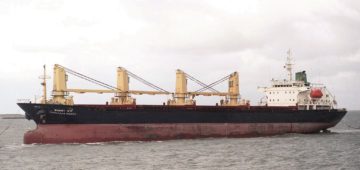



Comments
Sorry, comments are closed for this item